Greek art 1100 to 450 BC
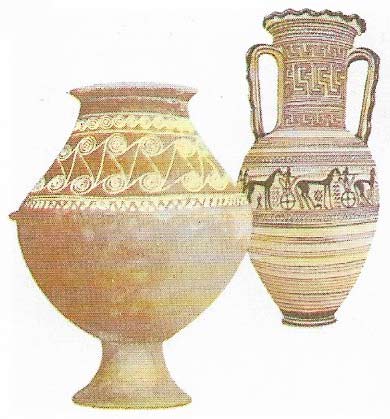
Figure 1. Protogeometric pottery, decorated with simple circles and wavy lines, probably originated in Athens before the end of the 11th century. As the potter's craft evolved, these motifs, often based on the patterns of basketworks and produced on a massive scale (up to 1.5 meter (5 feet) high), became more complex with the introduction of zigzags, friezes, and stylized figures of animals and men.
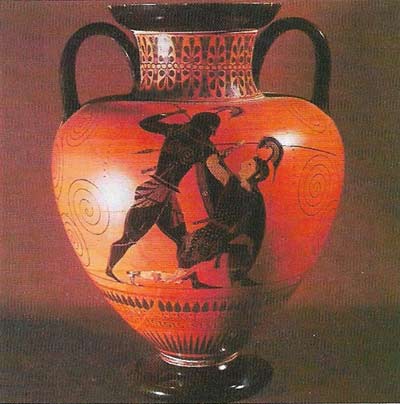
Figure 2. A masterpiece of black-figure painting, this amphora was made and decorated by Exekias (fl. c. 550–525 BC), the greatest painter of his time. It marks the rebirth after 600 BC of Athenian painting. Its detail captures the drama of the moment of death when, according to legend, the eyes of the Amazon queen, Penthesilea, met those of her slayer, Achilles, and she realized that he loved her.
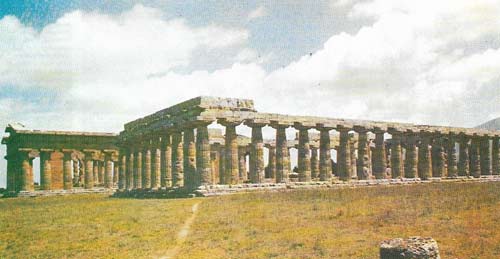
Figure 3. From earliest times the Greek architect's chief concern was with temple building. Based on the traditional house plan, and originally constructed in wood, their designs evolved until in the 6th century BC stone superseded wood. Many of the elements from carpentry, such as the adze-like grooves in columns, were retained. Originating in mainland Greece, the first and longest enduring of the "orders" – the Doric – was established. Although modified by western Greek colonists, the temple of Hera I at Paestum, Italy, retains all the classic Doric attributes and is one of the best surviving examples of the style.
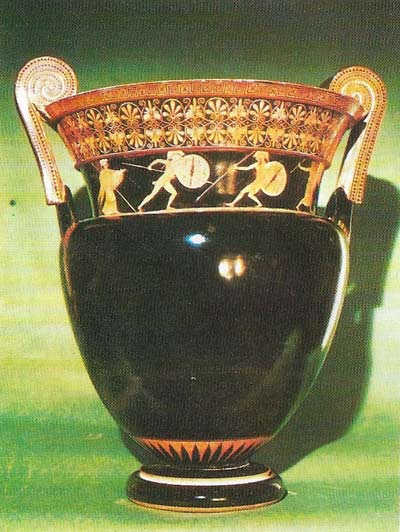
Figure 4. Red-figure vase-painting, in which the scenes are portrayed in sharp relief in red against an inky black background, began to supersede black-figure painting about 530 BC. This crater (a bowl for mixing wine and water) is a fine example of this stylistic evolution and depicts a scene from the Trojan Wars – Achilles and Hector in mortal combat. It marks a development that led to the mastery of draftsmanship.
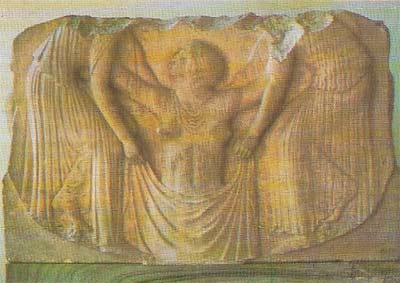
Figure 5. The "Ludovisi Throne" of the transitional late Archaic/early Classical period is remarkable for the fine quality of its molding, particularly the effect of the clinging wet hair and clothes. Once in the collection of a Roman cardinal, it is of obscure origin and use but is perhaps part of an altar. The work of a western Greek artist, it shows the birth of Aphrodite from the sea, aided by two attendants.
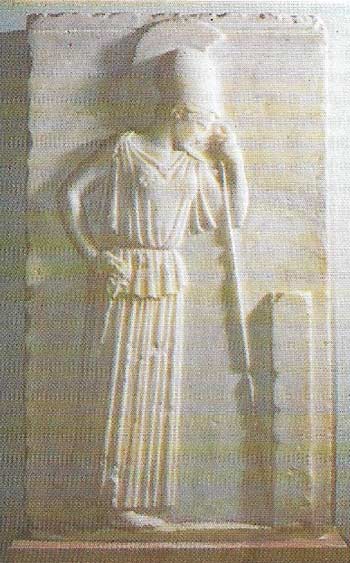
Figure 6. One of the finest examples of the sculpture of the Attic period is the so-called "Mourning Athena". The blending of full and three-quarter profile views is boldly executed and the facial expression and relaxed and natural posture of the subject vividly convey a pensive mood appropriate to the purpose. It was once thought that the relief showed Athena mourning by a grave marker, but it is now held that the goddess sands beside a terma, the starting point of a race. The craftsmanship anticipates the perfection of the sculpture of the Classical age.
Greek art and architecture underwent in seven centuries a gradual but profound change, from a primitive phase to a high level of refinement on the brink of the Classical period – the period that has exerted an enduring aesthetic and technical influence on the art of our own era. The objectivity and naturalness achieved in the Greek image of the human figure has remained the norm of later societies in the West. But it should be realized that because of the disappearance of textiles and woodwork and the paucity of early metalwork, the bare stone of ruined temples and the weathered surfaces of sculptures convey no impression of the original color and variety of Greek art.
The origins of Greek art lie in the Mycenaean culture of the 16th century BC. Following its overthrow in the 12th century there was a "dark age". The only examples of the material culture of this time are vases bearing simple linear devices in a style known as protogeometric (Figure 1). The real birth of Greek art, however, was effectively a rebirth – the renaissance of the 9th and 8th centuries BC, by which time the development of trade and the demands that a settled society made on its craftsmen produced a range of functional and aesthetically pleasing objects.
The zigzags and other motifs of the geometric art that flourished between c. 900–700 BC became progressively bolder and more elaborate and gradually figures of men and animals were included. Stylized figures were presented in a purely conceptual manner, with no attempt to depict perspective or movement. These early scenes of funeral processions and battles were a breakthrough; they were the first steps towards the narrative art that was to become the dominant feature of the work of Greek artists who drew on the heroic acts of the Iliad and Odyssey for inspiration.
The High Archaic period
The High Archaic period of 725–600 BC saw an Oriental influence, developing particularly out of the trade with the Phoenicians. Craftsmen from Cyprus and Syria worked in Crete and Attica and their innovations were assimilated by the native Greeks. Floral and curving patterns were added to straight line motifs and distinctive styles emerged in the painting of Corinth and Sparta.
Athens originally the acknowledged center of geometric painting, engaged less in trade and colonization and for a time was eclipsed artistically. But as a direct result of the importation of ideas from Egypt, this period saw the first major works of Greek architecture. Based on the temple design of Egypt, wooden columns and other features were progressively replaced by their equivalents in stone and the "orders" of Greek architecture emerged, beginning with the Doric in the second half of the seventh century. Sculpture also developed under Eastern influence – originally employing molds for the casting of small stereotyped images for shrines. By about 640, however, larger statues, derived from Egyptian models, were being manufactured. Plentiful domestic supplies of marble and ancillary materials, such as emery for smoothing, were exploited. During this time the tradition of the kouros figure was established. Although owing much in stance and manufacturing technique to earlier Egyptian works, a distinctive Greek style emerged. The Greek preoccupation with athletic sports meant that figures of youths were characteristically naked and, through the requirements that this form imposed, sculptors were compelled to study anatomy in greater detail – an important factor in the development of Greek sculpture.
 |
| Kouroi are figures of naked youths that are derived from Egyptian examples. They are often used as grave markers and are typically elegant with clenched hands and one foot advanced. |
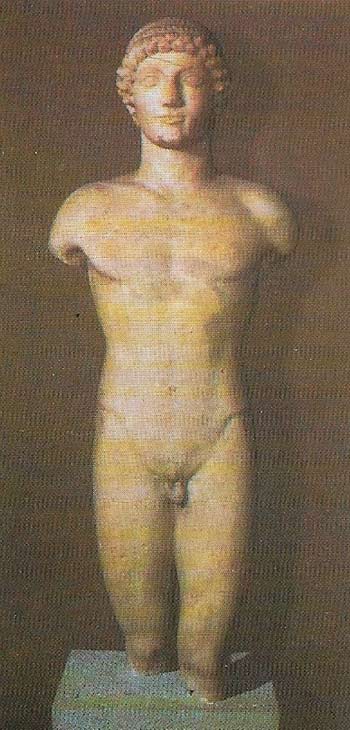 |
| An outstanding example of free-standing sculpture from the late Archaic/early Classical period, the "Strangford Apollo" (after its former owner, Lord Strangford) marks the consummation of over a century in the evolution of kouros sculpture. The early stiffness and formality of style was replaced by an increasing awareness of anatomical accuracy in sculpture. |
Corinth, a center for pottery
By about 700 BC, Corinth had taken the lead as the great Greek pottery center, and the black-figure technique pioneered and perfected there persisted for over 200 years. During the Archaic period, Greece was experiencing a new-found prosperity. Her colonial expansion was virtually complete and the development of stable cities provided the patronage that encouraged a wide range of artistic endeavors to flourish. Temple building increased and the Ionic order was introduced; temples became more elaborate and they were decorated with sculptured friezes of increasingly great artistry. An ever-growing understanding of human anatomy was applied both to a more naturalistic style of sculpture in the round and in relief and to the establishment in vase painting of a set of formal gestures and an iconography on which many unrivalled masterpieces of black-figure painting were based.
Athens and red-figure paintings
By 530 BC, red-figure painting had been invented (Figure 4) and Athens had become the chief center of the style which, as a result of its superiority in allowing greater attention to detail, soon ousted the black-figure technique. The artistic feeling of the Early Classical period (c. 500–450 BC) was profoundly affected by devastating social, economic and especially psychological consequences of the Persian Wars (490–478 BC). The most striking examples of this are seen in the dramatic abandonment of the "Archaic smile" expression and its replacement by a more sober and objective rendering of faces. As the most sudden change in artistic outlook for many centuries it was to contribute greatly to the humanistic "detached calm" that characterizes the subsequent period.
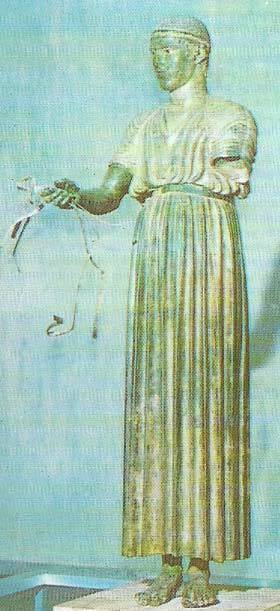 |
| The life-sized bronze statue of a charioteer, commissioned c. 470 BC as an offering in celebration of a victory by a Sicilian tyrant, Polyzalus of Gela, is of exaggerated proportions because it was designed to be viewed from below and partly concealed by the coachwork of the chariot in which it once stood. Although superficially architectural, the modeling and stance of the figure are subtle and brilliantly conceived, making it a classical masterpiece. |
